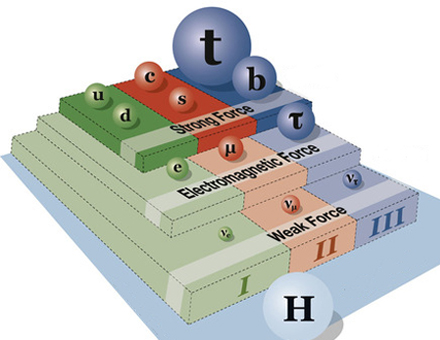Measuring the pole mass of the top quark with high precision
 As the mass of the top quark is very heavy, and thus its coupling to the Higgs boson is large, an accurate knowledge of its value is crucial to check the validity of the Standard Model of particle physics. The stability of the Higgs field itself, for instance, is not established yet, and one of the most important sources of uncertainty is the value of the top mass.
As the mass of the top quark is very heavy, and thus its coupling to the Higgs boson is large, an accurate knowledge of its value is crucial to check the validity of the Standard Model of particle physics. The stability of the Higgs field itself, for instance, is not established yet, and one of the most important sources of uncertainty is the value of the top mass.
At the moment the best measurements achieve a precision of around 0.7 GeV, but the experimental procedure used in these determinations consists essentially in reconstructing the invariant mass of the decay products of the top: it's the so-called direct measurement or measurement of the kinematic mass. In order to capture the complex physics of the production and subsequent decay of the top quark, which includes the generation of showers and the formation of hadrons from the produced partons, these methods employ Monte Carlo event generators that simulate the whole process and show how to deduce the parameters of the model from the observed final state. Unfortunately those event generators incorporate the low-energy strong interactions by means of hadronisation models, and as a consequence the top mass they yield is not a well-defined quantity in QCD: it is not a mass evaluated in a specific renormalisation scheme, and neither it is the "pole" mass, which is the quantity directly linked with the top coupling to the Higgs.
In practice this means that the purely kinematic determinations of the top mass are affected by an additional theoretical uncertainty, estimated in around 1 GeV, due to the fact that we interpret our measurement as the pole mass when it is actually a parameter influenced by the Monte Carlo generators and their treatment of the low-energy processes. It is thus of paramount importance to find new procedures to determine the top mass, and to do it in a QCD-definite way.
A method developed in 2013 by a team of experimentalists from IFIC and theoreticians from Humboldt University in Berlin, DESY and LBNL laboratories and University of California in Berkeley shows promise in this quest. The method consists in measuring the normalised differential cross section of top-antitop + 1-jet events as a function of the inverse of the invariant mass of the system; this observable is sensitive to the top mass because the amount of gluon radiation of the system depends precisely on this mass. This procedure provides us with a way to measure the top mass that does not rely solely on kinematics and allows to incorporate well-defined QCD parameters.
Using this method and data recorded by the ATLAS experiment during the year 2011 the team at IFIC has measured the pole mass of the top quark with an uncertainty of 2.2 GeV, which is the most precise detemination to date and is in good agreement with previous values and with those deduced from kinematic measurements. The group is already working to incorporate the data recorded by ATLAS on the year 2012 and onwards, and with them they are confident to reduce the uncertainty down to the benchmark of 1 GeV.
"A new observable to measure the top-quark mass at hadron colliders", S. Alioli, P. Fernández, J. Fuster, A. Irles, S. Moch, P. Uwer, M. Vos. Eur.Phys.J. C73 (2013) 2438, arXiv:1303.6415
"Determination of the top-quark pole mass using tt+1-jet events collected with the ATLAS experiment in 7 TeV pp collisions", ATLAS Collaboration. JHEP 10 (2015) 121, arXiv:1507.01769
















